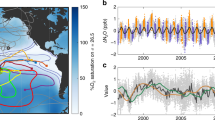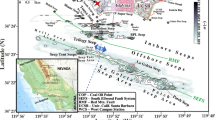Abstract
MAUNA Loa Observatory, located 3,400 m above sea level on the island of Hawaii in the middle of the Pacific Ocean, is a critical site for determining the background chemical reactivity of the unpolluted atmosphere and for monitoring its rate of change on a global scale. However, recent measurements of soluble nitrogen (principally HNO3) at the observatory find mixing ratios rising from their expected background values of 0.02–0.03 parts per 109 by volume (p.p.b.v.) in the winter to 0.07–0.12 p.p.b.v. in late summer with three-hour events as high as 0.25 p.p.b.v. (ref. 1). This raises the specific question of contamination by the long-range transport of pollution1 and a broader question of the chemical variability of the background atmosphere. Here we show that a general circulation transport model which simulates the global spread and deposition of emissions from fossil-fuel combustion can reproduce the nitrogen measurements at the Mauna Loa Observatory. By isolating individual source regions, we show that US emissions are responsible for the late summer increase and that Asian emissions cause a smaller increase in the spring. These simulations, together with the earlier observations, indicate frequent contamination of the Mauna Loa Observatory by the long-range transport of reactive trace gases, such as HNO3, and suggest a highly variable background atmosphere. It is essential that we are aware of such variability in order to discern anthropogenic effects on the atmosphere.
This is a preview of subscription content, access via your institution
Access options
Subscribe to this journal
Receive 51 print issues and online access
$199.00 per year
only $3.90 per issue
Buy this article
- Purchase on Springer Link
- Instant access to full article PDF
Prices may be subject to local taxes which are calculated during checkout
Similar content being viewed by others
References
Galasyn, J. F., Tschudy, K. L. & Huebert, B. J. geophys. Res. 92, 3105–3113 (1987).
Levy, H. II & Moxim, W. J. Nature 328, 414–416 (1987).
Levy, H. II & Moxim, W. J. Tellus (in the press).
Mahlman, J. D. & Moxim, W. J. J. atmos. Sci. 35, 1340–1374 (1978).
Manabe, S. & Holloway, J. L. Jr J. geophys. Res. 80, 1617–1649 (1975).
Manabe, S., Hahn, D. G. & Holloway, J. L. Jr J. atmos. Sci. 31, 43–83 (1974).
Levy, H. II, Mahlman, J. D., Moxim, W. J. & Liu, S. C. J. geophys. Res. 90, 3753–3772 (1985).
Malkus, J. S. in The Sea, Vol. 1 (ed. Hill, M. N.) 88–294 (Wiley, New York, 1962).
Nickerson, E. C. & Dias, M. A. J. appl. Met. 20, 868–873 (1981).
Oort, A. H. NOAA prof. Pap. 14 (National Oceanic and Atmospheric Administration, Rockville, Maryland, 1983).
Robinson, E. & Harris, J. J. geophys. Res. 92, 14685–14687 (1987).
Uematsu, M. et al. J. geophys. Res. 88, 5343–5352 (1983).
Parrington, J. R. & Zoller, W. H. J. geophys. Res. 89, 2522–2534 (1984).
Merrill, J. T., Bleck, R. & Avila, L. J. geophys. Res. 90, 12927–12936 (1985).
Author information
Authors and Affiliations
Rights and permissions
About this article
Cite this article
Levy, H., Moxim, W. Influence of long-range transport of combustion emissions on the chemical variability of the background atmosphere. Nature 338, 326–328 (1989). https://doi.org/10.1038/338326a0
Received:
Accepted:
Issue Date:
DOI: https://doi.org/10.1038/338326a0
This article is cited by
-
A review of atmospheric chemistry observations at mountain sites
Progress in Earth and Planetary Science (2016)
-
Separation, detection and occurrence of (C2?C8)-alkyl- and phenyl-alkyl nitrates as trace compounds in clean and polluted air
Fresenius' Journal of Analytical Chemistry (1994)
-
Measurement of gaseous HNO3 over the Atlantic Ocean
Journal of Atmospheric Chemistry (1992)
-
Die Wind-getriebene ?biologische Pumpe? und der Kohlenstoffentzug im Ozean
Naturwissenschaften (1990)
Comments
By submitting a comment you agree to abide by our Terms and Community Guidelines. If you find something abusive or that does not comply with our terms or guidelines please flag it as inappropriate.



